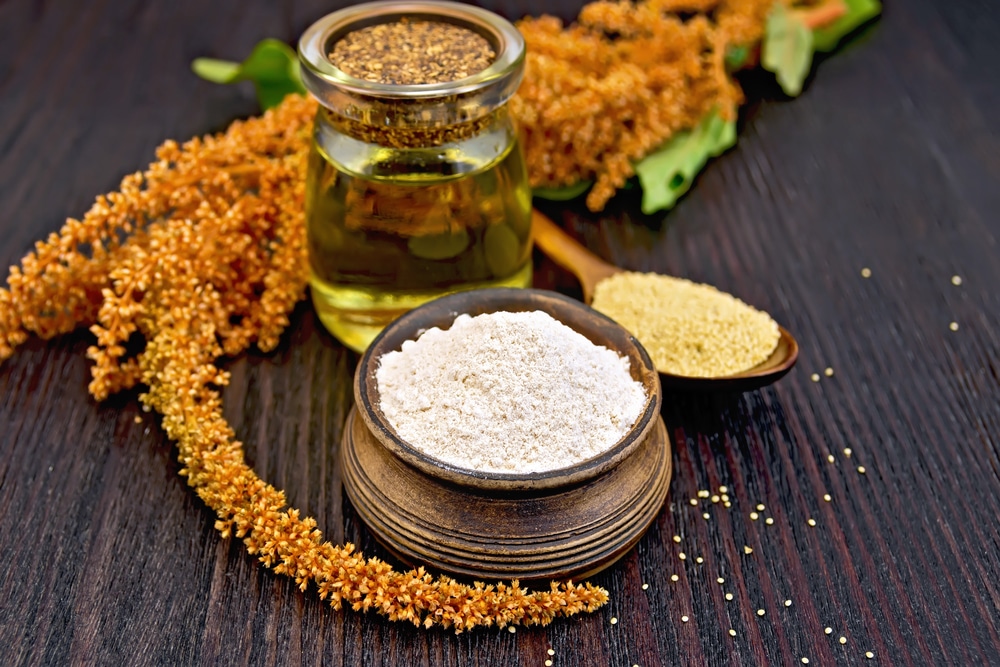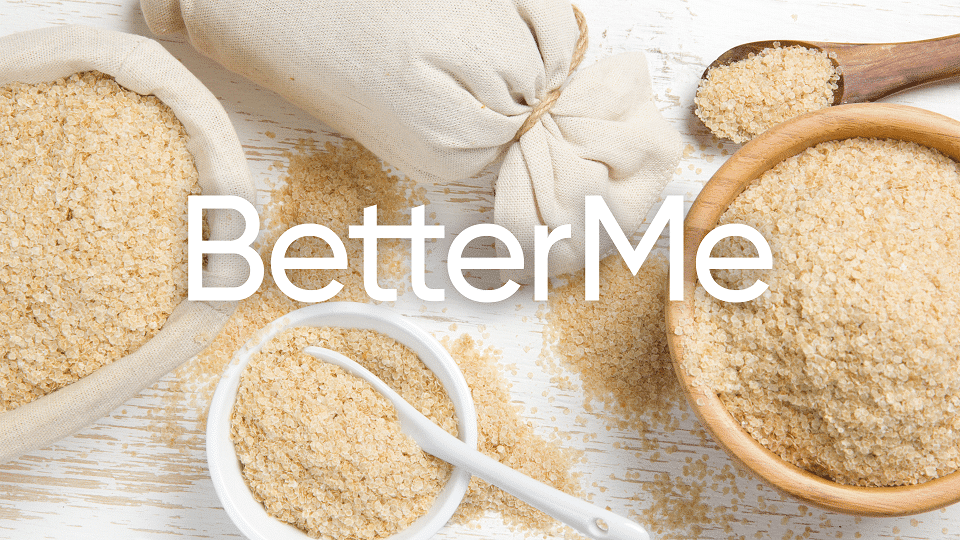The amaranth grain is classified as a pseudocereal. This means that it is not a true cereal, but shares the same properties as cereals. Amaranth is also referred to as an ancient grain and is often consumed by those looking to maintain a healthy lifestyle. Although it only just recently gained popularity, this grain has been cultivated for more than 3,000 years. The leaves can be eaten in a similar way to spinach, and many cultures dried the seed to create porridge or flour for baking. Amaranth is gluten-free, high in protein and fiber, and contains all essential amino acids making it an ideal health food. In this article, we’ll take a closer look at amaranth, including its benefits and potential side effects.
What Is Amaranth?
Amaranth (pronounced ah-marr-an-th) is an ancient grain that has recently gained popularity. It was a staple food of the Aztecs and an integral part of Aztec religious ceremonies. For some years it grew as a weed in South American cultivated crops, and was first identified as a pseudocereal in the early 1900s.
Amaranth is sometimes referred to as the “mother of all grains” because it provides an excellent source of nutrition, possibly more so than any other cereal grain. It’s commonly used as an herbal supplement for those looking for a healthy lifestyle.
Amaranth Nutrition Facts
One cup (246 grams) of cooked amaranth contains the following nutrients (1):
- Calories: 251
- Protein: 9.3 grams
- Carbs: 46 grams
- Fiber: 5.2 grams
- Manganese: 91% of the DV
- Magnesium: 38% of the DV
- Phosphorus: 29% of the DV
- Iron: 29% of the DV
- Selenium: 25% of the DV
- Copper: 41% of the DV
Amaranth Health Benefits
Due to its nutritional profile, amaranth offers a host of potential health benefits, including:
Disease-Fighting Antioxidants
Free radicals are unstable molecules that may damage cell membranes, DNA, and blood vessels. Amaranth contains an assortment of antioxidants that help to fight free radicals and promote overall good health (5).
These seeds are particularly rich in phenolic acids, including gallic acid, p-hydroxybenzoic acid, and vanillic acid. These antioxidants may help protect against diseases like heart disease and cancer (5).
Raw amaranth seeds are also high in vitamin C, carotene, and zeaxanthin. These three phytonutrients are believed to have antioxidant properties that help protect the eyes from damage as we age (5).
Heart Health
Amaranth is good for your heart for several reasons.
Firstly, it contains plant sterols. These are compounds believed to help lower LDL cholesterol. Secondly, amaranth is high in magnesium (5). Researchers have found that people with a magnesium deficiency are more likely to suffer from heart disease and stroke (4).
Finally, it’s very high in fiber, which can help to reduce cholesterol levels by reducing the absorption of dietary cholesterol (5).
Read More: Why Is Gluten Bad For You? Analyzing The Harm Behind This Food
Improved Digestion
Amaranth seeds contain both soluble and insoluble fiber, which contribute to good colon health. Soluble fiber forms a gel-like substance in the digestive tract and helps keep wastes moving through the intestines. Insoluble fiber adds bulk to stool and makes elimination easier and more comfortable (5).
Amaranth can also help to balance levels of healthy gut bacteria. These beneficial bacteria help the body to digest food and absorb nutrients, as well as fight off disease-causing germs (5).
Weight Loss
Amaranth is a healthy weight loss food for several reasons:
It’s low in calories and fat, yet high in protein and fiber. Fiber expands in the stomach and fills you up with fewer calories. The amino acids amaranth contains help to increase satiety and reduce appetite (3).
Amaranth is quite versatile and can be incorporated into healthy snacks and meals. It’s easy to cook and tastes delicious with a variety of seasonings.
To maximize the weight loss effects of these seeds, it’s advisable to include them with overall healthy dietary choices and an active lifestyle. There is no such thing as a single “miracle” weight loss food.
Blood Pressure Control
Amaranth is high in magnesium and potassium, two minerals that work together to control blood pressure. This effect might be particularly noticeable when these seeds are served with other food sources of magnesium and potassium, such as fish and avocados (5).
Skin Health
Amaranth seeds are high in vitamin E and some B vitamins, which promote healthy skin and hair. Vitamin C in amaranth can also help reduce fine lines and wrinkles (5).
Calm Heartburn
Amaranth is rich in soluble fiber, which forms mucilage when it interacts with water (5). Mucilage is sticky and gummy, like tree sap or glue. Because of this property, amaranth might help absorb and reduce stomach acid to calm the burn of heartburn and acid reflux.
Celiac Disease
Though amaranth is related to gluten-containing grains like wheat, barley, and rye, it contains neither gluten nor the negative health effects of gluten for sensitive people. Thus, some people with celiac disease can tolerate amaranth without suffering adverse reactions (5).
Celiac patients have to be careful, however—a few studies have shown that a handful of people do react poorly to amaranth (5).
In rare cases, this reaction can be severe. People who are concerned about gluten cross-reactivity should discuss the matter with a doctor or dietitian before adding amaranth to their diets.
BetterMe app is a foolproof way to go from zero to a weight loss hero in a safe and sustainable way! What are you waiting for? Start transforming your body now!
Amaranth Side Effects
Generally, these seeds are a safe food for most people. As with any new ingredient, though, there are some side effects to watch out for:
Antinutrients In Amaranth
Antinutrients are naturally occurring compounds that interfere with the absorption of nutrients. Amaranth seeds contain these antinutrients, including saponins and tannins.
Saponins, which occur in many different plant species, coat the cells of amaranth seeds to protect them from insects and animals. As amaranth seeds age, the saponins break down and become less effective (2).
Though they’re not toxic to humans, saponins can interfere with nutrient absorption and cause some unpleasant side effects. For example, saponins may trigger digestive issues like gas and bloating (2).
Tannins, on the other hand, can affect nutrient absorption but they aren’t thought to cause gastrointestinal problems like gas and bloating (2).
For healthy people with nutritious, balanced, and varied diets, antinutrients are usually not an issue. Sprouting or soaking amaranth seeds reduces the effects of saponins and tannins.
How To Use Amaranth
These seeds are simple to prepare and can be used in many different dishes. Before cooking amaranth, you can sprout it by soaking it in water and then allowing the grains to germinate for one to three days.
Sprouting amaranth makes it easier to digest and might improve its nutritional content. Sprouted amaranth is a particularly good choice for those with weak digestive systems or food sensitivities.
To make sprouts, simply place the seeds in a glass jar and fill it with water. Place a piece of cheesecloth over the mouth of the jar and secure it tightly with a rubber band. Then, allow it to sit overnight.
After soaking, drain out the water and set the jar in a warm, dark place for one to three days, until the sprouts reach about an inch in length. Rinse them with fresh water before using them in recipes or on salads.
Amaranth can be used as:
Ground Flour
Pastries made from amaranth flour taste wonderful and are easy to make.
Ground amaranth makes a wonderful, gluten-free substitute for wheat flour in many recipes. It can even be used to make delicious pancake and waffle batters.
You can easily substitute amaranth flour for traditional wheat flour in any cookie recipe. Add one tablespoon of water or milk per one cup of amaranth flour to create a dough that is similar in texture to traditional cookie dough.
Amaranth Porridge
You can serve amaranth porridge hot or cold. To prepare it, bring water or milk to a boil and then slowly pour in the dry grain, stirring all the while. Reduce the heat to low and simmer uncovered for 10-15 minutes. Stir in sweetener, if using, and seasonings.
Amaranth Milk
The best way to make amaranth milk is by sprouting the seeds, blending them with water in a high-speed blender , pouring the blended mixture through cheesecloth or a sieve (to separate out the pulp), then squeezing out the excess liquid. The remaining pulp can be used to create a quick amaranth porridge.
Read More: Pescatarian Meal Ideas: Healthy, Quick, And Easy Recipes
Amaranth Frozen Dessert
Add some amaranth flour to a blender with your favorite fruit and sweetener, then blend until smooth. Pour into an ice cube tray and freeze overnight. Enjoy as a healthy frozen treat!
In Place Of Pasta Or Rice
These seeds can be used as a healthy alternative to traditional carb-heavy side dishes. For example, try stirring some into chicken and vegetable soup or sprinkle it on salads and veggies for a nutty flavor and extra protein boost.
Amaranth Tabbouleh
In the Middle East, bulgur wheat or couscous are often used to make tabbouleh, a popular dish with Middle Eastern origins. In an effort to explore new flavors and vegetarian ingredients, many people have been tweaking their tabbouleh recipes with amaranth to great results.
Amaranth In Smoothies
Amaranth can be used to create healthy, nutritious smoothies. Start by pouring ½ cup of milk over one tablespoon of amaranth flour and one scooped-out frozen banana (peel and all). Add any other ingredients you like: berries, almonds, cocoa powder, honey—you name it! Then blend until smooth and enjoy.
Intense sweat sessions, working weight loss tips, lip-smacking recipes come in one package with the BetterMe app. And all of it is at your fingertips, start transforming your life now!
As A Breakfast Topping
Stirring amaranth flour into your morning oatmeal or yogurt can help you feel full longer and provide some extra fiber, protein, and nutrients throughout the day.
As A Breading
Amaranth can be used as a gluten-free alternative to bread crumbs. Simply grind the seeds with salt, pepper, and any other spices or herbs you want to add, then coat your protein or vegetables with the mixture before sautéing.
The Bottom Line
Amaranth can be prepared in a variety of different ways and used in many recipes. It is also very nutritious and may help to fight disease. These benefits have led to a rise in the popularity of this superfood over the past couple decades.
DISCLAIMER:
This article is intended for general informational purposes only and does not serve to address individual circumstances. It is not a substitute for professional advice or help and should not be relied on for making any kind of decision-making. Any action taken as a direct or indirect result of the information in this article is entirely at your own risk and is your sole responsibility.
BetterMe, its content staff, and its medical advisors accept no responsibility for inaccuracies, errors, misstatements, inconsistencies, or omissions and specifically disclaim any liability, loss or risk, personal, professional or otherwise, which may be incurred as a consequence, directly or indirectly, of the use and/or application of any content.
You should always seek the advice of your physician or other qualified health provider with any questions you may have regarding a medical condition or your specific situation. Never disregard professional medical advice or delay seeking it because of BetterMe content. If you suspect or think you may have a medical emergency, call your doctor.
SOURCES:
- Amaranth grain, cooked (2019, usda.gov)
- Nutrients and antinutrient constituents of Amaranthus caudatus L. Cultivated on different soils (2020, science direct.com)
- Protein, weight management, and satiety (2008, oup.com)
- Serum Magnesium and the Risk of Death From Coronary Heart Disease and Sudden Cardiac Death (2016, ahajournals.org)
- State of Knowledge on Amaranth Grain: A Comprehensive Review (2012, wily.com)














